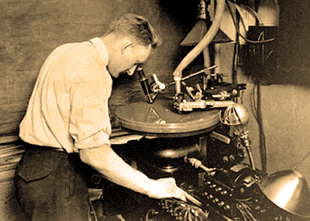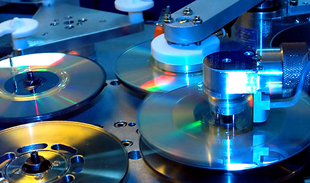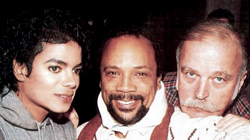![]() ‘People can say that they like the ‘sound’ of analogue, but to say that analogue recording systems are superior to digital systems is flying in the face of all the evidence.
‘People can say that they like the ‘sound’ of analogue, but to say that analogue recording systems are superior to digital systems is flying in the face of all the evidence.
‘I know that analogue tape recorders sound excellent on some types of recording, but they sound worse on others – and there are other ways of achieving analogue sounds, without suffering the sonic limitations that go with them.’
So says Philip Newell, studio designer and seasoned recording engineer. And he’s got plenty more to say on the subject. It may not make pleasant reading for those who still regard digital audio systems as inferior to analogue, but it is all founded in front-line experience, solid reasoning and objective listening. It might even make some of you think again.
 ‘I was over the moon when CD arrived – I could avoid having to sacrifice musical dynamics for fear of needles jumping out of grooves,’ he begins. ‘I no longer had to worry about the overall length of each side of a record, or shuffling the song order on a cassette to give an equal running time on each side.’
‘I was over the moon when CD arrived – I could avoid having to sacrifice musical dynamics for fear of needles jumping out of grooves,’ he begins. ‘I no longer had to worry about the overall length of each side of a record, or shuffling the song order on a cassette to give an equal running time on each side.’
All artistically dubious practices, admittedly. Over to you Philip…
‘I also remember spending many hours listening to test pressings of vinyl discs and rejecting a great proportion of them because of pops and clicks, either from imperfections of the stampers or from impurities in the vinyl itself. CD was a godsend. I never looked back to vinyl.
‘One of the last mixes that I did for Mike Oldfield was a live version of the Gershwin brothers’ ‘I Got Rhythm’, for his Impressions album. I mixed a really dynamic intro, which the A&R people at Virgin liked very much. But even with the help of the finest disc cutting engineers of the time, there was no way that we could expect to get this back off disc without using such a low overall level that it would have been unacceptable in terms of surface noise.
‘If the CD had arrived two years earlier, that recording (made by Chris Jenkins, the designer of the SSL AWS900) would now be one of my favourite live recordings. I could never listen to the vinyl version without thinking of what it could have been.’
Vinyl just doesn’t cut it
These sentiments are neatly echoed by Peter Gabriel in the BBC/Isis/Eagle Rock television Classic Albums documentary study of his 1986 album release, So.
‘You tend to forget about those days when 22 or 24 minutes were all you could pack onto an album if you wanted the bass to have any power to it,’ Gabriel says, discussing the move of ‘In Your Eyes’ from opening the second side of the vinyl album to closing the 2002 CD release – where he had wanted it all along.
Gabriel recalls how he had recorded all of the intros and ends of the album’s songs onto separate cassettes in order to establish their running order, but then had to place ‘In Your Eyes’ where the grooves have their greatest linear velocity in order to accommodate its bass content. One of the programme’s other commentators – Rolling Stone Senior Editor David Fricke – then concedes that the resequencing of the tracks is one of ‘those rare instances when the CD is better than the album’. A reluctant acknowledgement of the musical merit of the format.
Then there is the issue of different formats’ mastering requirements. Philip?
 ‘I have been involved in the preparation of countless production masters of music, many of which I had recorded and/or mixed myself, for release on vinyl, cassette, CD, SACD or DVD. Very few of the finished products, to the best of my recollection, were made from the same masters. We “tinkered” with the equalisation and dynamics in an attempt to optimise the production masters for each of the respective release media. For this reason, it can be absolutely futile to compare a CD version and a vinyl version of the same disc in terms of the sound quality. They are often not made from the same master.
‘I have been involved in the preparation of countless production masters of music, many of which I had recorded and/or mixed myself, for release on vinyl, cassette, CD, SACD or DVD. Very few of the finished products, to the best of my recollection, were made from the same masters. We “tinkered” with the equalisation and dynamics in an attempt to optimise the production masters for each of the respective release media. For this reason, it can be absolutely futile to compare a CD version and a vinyl version of the same disc in terms of the sound quality. They are often not made from the same master.
‘People have often told how much they prefer the sound of the SACD of Tubular Bells to the various other versions. In reality though, it wasn’t made from the same mixes – or even mixed in the same studio. There is no way whatsoever of comparing its sound with that of any other version in any meaningful way, but people do exactly that, and speak seemingly knowledgably about many of the differences that, in fact, have nothing whatsoever to do with the delivery media.
‘I mixed the SACD version both with the benefit of hindsight and the best equipment that money could buy in the mid-1970s (and with the help of Mick Glossop and Alan Perkins), on a very advanced Helios mixing console that cost more than a new Rolls Royce at that time. Moreover, all the other mixes were done with the limitations of vinyl in mind, whereas during what turned out to be the SACD mix I was toying with the idea of a dbx Type ll encoded disc, which would have allowed much greater dynamic range than was usual for those days. No normal vinyl disc was ever made from the masters that were used for the SACD release in 2000, yet people still make comparisons. I am relating this story because it illustrates the type of absurd discussion that is rife these days.
‘From my own experience, it is evident that CDs are vastly superior to vinyl discs and can reproduce low-frequency square waves, which is an important indicator of the medium’s ability to follow transients. In the studios of the time, there was immense frustration when an absolutely fantastic tom-tom sound (or that from other percussive instruments with generous low-frequency content coming straight from the studio via the mixing console) simply would not come back from the analogue recording systems with anything but a disappointing lack of impact... from tape or disc.
‘I am sure that many people reading this will be familiar with the sound of being vigorously struck across the side of the face with a two-and-a-half kilo, wet haddock. This produces a tight, transient, heavy sound, the reproduction of which requires a system with a fast and highly damped transient response. Try getting an accurate reproduction of that thwack from an analogue recording system and it will not give the same sensation – the transient responses are just not good enough. CDs and other high-quality digital systems can reproduce that type of signal very precisely.
By definition, anything that cannot reproduce the sound correctly cannot be high fidelity.
 ‘When running-in new loudspeakers and setting up monitor systems in good control rooms I still use a CD of Michael Jackson’s Dangerous album. A look at the response of several of the tracks on a spectrum analyser makes it clear how it would be impossible to reproduce that sort of bass from vinyl. That CD has some very impressive dynamics, some very low frequencies and an extremely low noise floor. These are characteristics that can improve the reproduction of almost all types of music. It seems incomprehensible to me that all of the superior characteristics of digital recording can be globally ignored by people who nostalgically hang on to dreams of the superiority of vinyl.
‘When running-in new loudspeakers and setting up monitor systems in good control rooms I still use a CD of Michael Jackson’s Dangerous album. A look at the response of several of the tracks on a spectrum analyser makes it clear how it would be impossible to reproduce that sort of bass from vinyl. That CD has some very impressive dynamics, some very low frequencies and an extremely low noise floor. These are characteristics that can improve the reproduction of almost all types of music. It seems incomprehensible to me that all of the superior characteristics of digital recording can be globally ignored by people who nostalgically hang on to dreams of the superiority of vinyl.
‘Listen to the Dangerous CD via a flat, full-range loudspeaker system in a good room, and any thoughts of getting that sound from a vinyl disc will vaporise (as, no doubt, would the cutting head if anybody did try to put it unequalised on to an analogue disc. Also, I have some truly wonderful sounding CDs, but I can only access their prime quality via the use of some extremely good (and expensive) D/A converters. When I go to studios to check out the electro-acoustic systems I carry my own converters with me. More or less any reasonable CD transport will suffice, provided that it has a digital output, but any old reasonable converters will not do. This, I think, is one of the beauties of SACD – the D/A conversion is much easier, so their quality is more widely accessible to the public at affordable prices.
‘By comparison, CD conversion is neither simple nor cheap. In cases where I have not been able to use my own converters, or had access to converters of equal quality (and while listening via a high-resolution monitor system in a good room), the variability of the sound quality via the onboard converters of the various CD players has been alarmingly great. And yes, some of them have been tiring to listen to. However, this is obviously not any fault of the CDs themselves or their inherent limitations. It is simply a shortcoming of cheap converters.’
While the audiophile hi-fi press delights in championing vinyl over CD and analogue equipment holds a special place in the recording world, there is clearly a disconnect between the two, as Newell has made clear. The use of analogue components in the recording chain relates directly to the character of the sounds being recorded, while the fact that vinyl is an ‘analogue’ replay alternative to digital CD is largely irrelevant.
So, it appears that the constraints of long-playing vinyl records have played an inappropriate part in shaping their musical content both in its length and sequencing. And the important audio consideration with any replay medium is how accurately and reliably it performs. Now, what was the question? Oh yes, which is better, vinyl or CD?